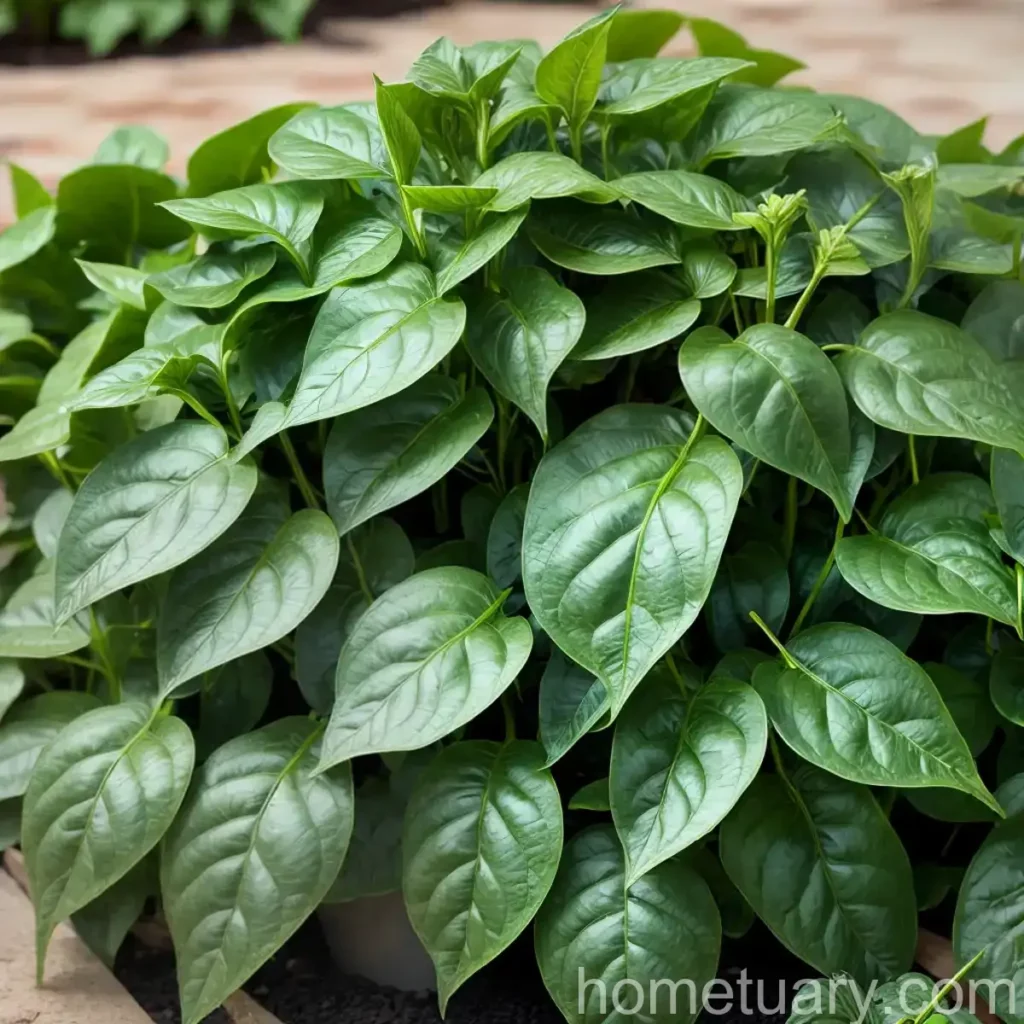Malabar Spinach: The Versatile and Nutrient-Rich Basella alba
The world of plants is filled with an incredible diversity of species, each with its unique characteristics, benefits, and uses. Among these diverse plants, one that stands out for its versatility and health benefits is Malabar spinach (Basella alba). Also known as Indian spinach, Ceylon spinach, or climbing spinach, Malabar spinach is a leafy green vegetable that has been valued for centuries for its culinary uses and medicinal properties.
In this comprehensive guide, we will delve into the various aspects of Malabar spinach, from its cultural requirements and uses to its health benefits and propagation techniques. Whether you are a gardening enthusiast, a nutrition-conscious individual, or someone interested in traditional herbal remedies, this guide will provide you with valuable insights into the world of Malabar spinach.
What is Malabar Spinach (Basella alba)?
Malabar spinach (Basella alba) is a fast-growing, vine-like plant that belongs to the Basellaceae family. Despite its common name, Malabar spinach is not botanically related to true spinach (Spinacia oleracea); however, it is often used as a spinach substitute due to its similar taste and culinary versatility. Originating from tropical Asia, Malabar spinach is well adapted to warm and humid climates, thriving in regions with ample sunlight and moisture.
Key Takeaways
Before we delve into the specifics of cultivating and caring for Malabar spinach, here are some key takeaways to pique your interest in this remarkable plant:
- Malabar spinach, scientifically known as Basella alba, is a nutrient-rich leafy green vegetable with a taste and texture similar to spinach.
- It is valued for its versatility in culinary applications and is used in a wide range of dishes, including soups, stir-fries, and salads.
- Cultivating Malabar spinach requires attention to its water, sunlight, soil, and pruning needs, ensuring optimal growth and productivity.
- The plant can be propagated from seeds or cuttings, making it a rewarding addition to home gardens and container settings.
- While relatively low-maintenance, Malabar spinach may be susceptible to certain diseases and pests, requiring proactive management strategies.
Now, let’s explore the various aspects of Malabar spinach, from its cultural requirements to its uses and potential health benefits.
Cultivation
Water
Proper watering is crucial for the healthy growth of Malabar spinach. As a tropical plant, it thrives in moist conditions and benefits from regular, consistent watering. In regions with adequate rainfall, supplemental watering may be necessary during dry spells to ensure that the soil remains consistently moist. However, it is important to avoid overwatering, as waterlogged soil can lead to root rot and other moisture-related issues.
Sunlight
Malabar spinach flourishes in full sunlight, making it an ideal addition to sunny garden beds, balconies, and patios. When grown in containers, ensure that the plant receives at least 6-8 hours of direct sunlight each day for optimal growth and productivity. In regions with intense heat, providing partial shade during the hottest part of the day can help prevent sunburn and heat stress.
Fertilizer
To support healthy growth and abundant foliage, it is beneficial to provide Malabar spinach with a balanced fertilizer during the growing season. A general-purpose, slow-release fertilizer can provide the necessary nutrients for the plant’s vigorous growth. When planting in nutrient-poor soil, amending the soil with organic matter such as compost or well-rotted manure can enhance the fertility and structure of the soil, promoting robust growth.
Soil
Malabar spinach thrives in well-draining, fertile soil with a slightly acidic to neutral pH. Loamy or sandy loam soils are ideal for this plant, offering good aeration and moisture retention. Prior to planting, preparing the soil by incorporating organic matter and ensuring proper drainage can create an optimal growing environment for Malabar spinach.
Pruning
Regular pruning and harvesting are essential for promoting continuous growth and ensuring a steady supply of tender leaves. When the plant reaches a height where it can be harvested, regular pinching back of the growing tips encourages branching and bushier growth. This practice not only promotes a more compact and leafy plant but also encourages the production of fresh, tender foliage for culinary use.
Propagation
Malabar spinach can be propagated from both seeds and cuttings, providing multiple options for expanding your plant collection or sharing with fellow gardening enthusiasts. Here are the basic methods for propagating Malabar spinach:
-
Seeds: Malabar spinach seeds can be sown directly into the garden bed or containers once the risk of frost has passed and the soil temperature has warmed to around 70°F (21°C). Sow the seeds at a depth of 1/2 inch (1.3 cm) and maintain consistent moisture until germination occurs, typically within 7-14 days.
-
Cuttings: Stem cuttings taken from healthy, established plants can be rooted in a well-draining potting mix to create new plants. Select a 4-6 inch (10-15 cm) cutting with several leaves, remove the lower leaves, and place the cutting in a container of moist potting mix. Provide gentle bottom heat and humidity to encourage root development, and transplant the rooted cutting into a larger container or the garden bed once roots have formed.
Container Popularity
Malabar spinach’s vining habit and compact growth make it an excellent candidate for container gardening. Whether you have a sunny balcony, patio, or small backyard, growing Malabar spinach in containers allows you to enjoy a fresh supply of nutritious greens without the need for a traditional garden plot. Its ornamental foliage and climbing nature also make it an attractive option for vertical gardening, trellising, and arbors in container settings.
Container
When selecting a container for Malabar spinach, choose a pot that is at least 12 inches (30 cm) in diameter and similarly deep to accommodate the plant’s robust root system. Ensure that the container has adequate drainage to prevent waterlogging, and use a high-quality potting mix that offers good aeration and moisture retention. Consider adding a trellis or stakes to support the vining growth and maintain an organized and visually appealing container garden.
Common Diseases
While relatively resistant to diseases, Malabar spinach may be susceptible to certain issues, particularly in conditions of high humidity and poor air circulation. Some of the common diseases that may affect Malabar spinach include:
-
Powdery Mildew: A fungal disease that presents as white or gray powdery patches on the leaves, powdery mildew can weaken the plant and reduce its vigor. Providing good air circulation, avoiding overhead watering, and applying a neem oil-based fungicide can help manage this disease.
-
Downy Mildew: Characterized by yellow patches on the upper leaf surface and a fuzzy, whitish growth on the undersides of the leaves, downy mildew is a common issue in humid conditions. Remove infected leaves, practice good sanitation, and apply copper-based fungicides to manage downy mildew.
Disease Diagnosis
When diagnosing and managing diseases in Malabar spinach, it is essential to monitor the plant closely for any signs of distress or abnormal growth. Identifying the specific symptoms and signs of diseases, such as unusual leaf discoloration, powdery or fuzzy growth, and wilting, can aid in accurately diagnosing the issue and implementing appropriate management strategies.
Common Pests
While generally resilient against pest infestations, Malabar spinach may occasionally encounter pests that can impact its growth and vitality. Some of the common pests that may affect Malabar spinach include:
-
Aphids: These small, soft-bodied insects feed on the sap of the plant, causing stunted growth and distorted leaves. Their presence can also lead to the development of sooty mold on the affected plant parts. Hand-picking or spraying with a strong stream of water can help control aphid populations.
-
Leaf Miners: These pests create narrow, winding tunnels in the leaves, leading to visible damage and reduced photosynthetic capacity. Prune and remove infested leaves to prevent the spread of leaf miners and discourage their presence in the garden.
Botanist’s Tips
-
Companion Planting: To enhance the health and productivity of Malabar spinach, consider companion planting with beneficial companion plants such as marigolds, nasturtiums, and aromatic herbs. These companion plants can help repel pests, attract beneficial insects, and improve the overall growing conditions for Malabar spinach.
-
Mulching: Applying a layer of organic mulch around the base of the plant can help retain soil moisture, suppress weed growth, and regulate soil temperature. Organic mulches such as straw, shredded leaves, or compost can also gradually decompose, enriching the soil and providing essential nutrients to the plant.
Fun Facts
-
The leaves and tender shoots of Malabar spinach are highly nutritious, rich in vitamins A and C, iron, and calcium, making it a valuable addition to a healthy diet.
-
Malabar spinach is a popular ingredient in Asian and tropical cuisines, often featured in stir-fries, soups, curries, and salads for its mild flavor and succulent texture.
-
The plant’s vibrant, glossy foliage serves as an eye-catching ornamental element in the garden, adding a touch of lush greenery to the landscape.
-
In addition to its culinary uses, Malabar spinach has been traditionally used in herbal medicine for its purported health benefits, including its potential antioxidant and anti-inflammatory properties.
Now that we have covered the cultural aspects of Malabar spinach, let’s explore its diverse uses in cooking, traditional medicine, and potential health benefits.
Links to External Resources
To further your exploration of Malabar spinach and its various uses, cultivation techniques, and health properties, consider referring to the following external resources:
- Malabar Spinach: Benefits and Culinary Uses
- Nutritional Value of Basella alba
- Growing Malabar Spinach in Containers
- Basella alba as a Medicinal Plant
- Malabar Spinach: Health Benefits and Care Tips
Exploring these resources can provide you with a wealth of information on Malabar spinach, from its nutritional composition and culinary uses to its potential medicinal properties and care guidelines.
Conclusion
Malabar spinach (Basella alba) is a remarkable plant with a rich history of culinary, medicinal, and ornamental significance. By understanding its cultural requirements, propagating methods, and potential uses, you can unlock the full potential of this versatile vegetable in your home garden or container setting.
Whether you are drawn to its vibrant foliage, its nutrient-rich leaves, or its culinary versatility, Malabar spinach offers a myriad of benefits and opportunities for exploration. From refreshing salads and hearty soups to traditional herbal remedies, the uses of Malabar spinach are as diverse as its cultural significance.
By incorporating Malabar spinach into your gardening endeavors and culinary creations, you can embark on a journey of discovery and appreciation for this exceptional plant, celebrating its cultural heritage and health-promoting properties.
Remember to explore the external resources provided to gain further insights into the world of Malabar spinach and enhance your knowledge of its cultivation, uses, and potential health benefits.
Happy gardening and culinary adventures with Malabar spinach!















